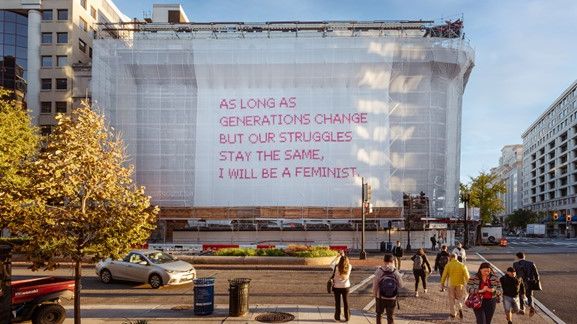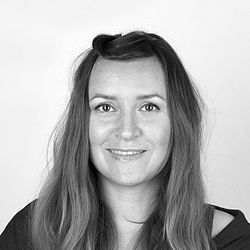
Pressemelding -
Norwegian Premiere in Trondheim: International public artwork on the facade of the Nordenfjeldske Kunstindustrimuseum
Press release 02.04.2025:
On April 2, Austrian artist Katharina Cibulka will mount a 176 m2, hand-embroidered scaffolding net on the facade of the Kunstindustrimuseum in Trondheim. This is the 32nd installment of the international SOLANGE art series for Cibulka and her team. The project was invited to Trondheim on the occasion of the Hannah Ryggen Triennale MATER. The Swedish-Norwegian concept and textile artist born in the 19th century is renowned for her hand-woven tapestries and was also an active pacifist and feminist.
SOLANGE is an international participatory art project. With its large lettering hand-embroidered onto scaffolding nets in bright pink tulle, it aims to raise awareness for gender inequalities people experience in our society. Every SOLANGE net features a sentence starting with “As long as...” and ending with “...I will be a feminist”. The nets create a field of tension between the traditionally gendered connotations of craftwork as female and construction sites as male spheres. Every net is preceded by a participatory process.
On November 23, 024, the artist was first invited to Trondheim for a series of lectures and workshops. Cibulka encouraged all interested locals to participate in SOLANGE by sending in their personal SOLANGE sentence via custom-made postcards or social media.
The response and range of topics were remarkable: around 100 SOLANGE sentences were submitted, addressing topics such as violence against women, toxic masculinity, a healthcare system that is primarily geared towards men, care work, body shaming, fear of assault and the climate crisis. In collaboration with the Norwegian literary poet Marte Huke, the SOLANGE team developed a poetic sentence open to several layers of interpretation while staying in tune with the issues called out by the Trondheim public.
Moreover, it incorporates a reference to Hannah Ryggen's artistic practice as an activist and textile artist.
“We feel incredibly happy and honoured that the Solange Team with artist Katharina Cibulka wanted to work with the museum and the Hannah Ryggen Triennale 2025 to create this embroidered scaffolding net. It is more important than ever that museums provide a democratic arena to share experiences, offer reflections and encourage dialogue. And with this monumental and public art work, we hope to open up to new conversations with our community and at the same time honouring the fierce and political art of Hannah Ryggen.”
says museum director Ingrid Lunnan
SÅ LENGE HUN LØSNER KNUTENE MENS HAN KNYTTER NEVENE, ER JEG FEMINIST.
SOLANGE SIE DIE KNOTEN ENTWIRRT, WÄHREND ER SEINE FÄUSTE BALLT, BIN ICH FEMINIST:IN.
AS LONG AS SHE UNTANGLES THE KNOTS WHILE HE CLENCHES HIS FISTS, I WILL BE A FEMINIST.
There is no textile crafting without knots. Knots are the point of connection between Hannah Ryggen's and Katharina Cibulka's work. The SOLANGE sentence uses a knot as its metaphorical theme:
The task of untangling knots is usually a tedious and painstaking process that involves patience and small steps. Communication between people can also be full of knots that need to be undone. By engaging in discussion and finding solutions, we can create a solid basis for peaceful coexistence and cooperation. It is about making space for dialogues aimed at compromise, not confrontation. Women and queer people often take on the task of diligently and patiently loosening and untangling communicative knots that others may have created.
Fists – which look like big knots – are clenched by those who cannot find words for their feelings, who feel helpless and powerless, who cannot control their anger; They are sometimes made by someone who seeks to intimidate and oppress others. All over the world, fists raised in anger are currently experiencing a wild revival as a symbol of (supposed) masculine strength and power. A fist smashes, strikes, becomes a weapon; it conjures up images of domestic violence as well as war. As the world order we know seems to be collapsing at a dizzying pace, armament has become the order of the day and proposed cure-all for autocratic power plays. The patriarchy is clenching its fists.
Katharina Cibulka elaborates:
“I share the concerns so many people have for peace in Europe. At the same time, the means of choice – global rearmament – seem absurd and backwards to me. We have already come much further. The Second World War with its immeasurable suffering taught us to prioritize efforts of maintaining peace through dialogue. Hannah Ryggen shared this view. The practices of dialogue, untangling knotted thoughts, weaving together threads of conversation and tying up agreements and treaties for the benefit of all humans have been neglected. The iron fist, domination of the strongest and loudest has quickly risen to the top, and suddenly, everyone tunes into warmongering rhetoric.
In my opinion, the challenge is to overcome the opposition between tenderness and destruction: to retain the power of the fist but to strip it of its violence; to untangle the knots using negotiation and dialogue and to work together to tackle the enormous problems we face. We are all called upon to untangle the knots in our minds, in misguided discourses, and to pick up the threads of conversation again, reaching out to one another to weave visionary fabrics. I am confident that art and feminism as socio-political forces can provide crucial impulses for this.
Press Contact Nordenfjeldske Kunstindustrimuseum:
Siri Frøseth
Head of Education and Exhibition,
Nordenfjeldske Kunstindustrimuseum
siri.froseth@mist.no
+ 4798029962
General Information
SOLANGE
Scaffolding nets hand-embroidered with cable ties and tulle are installed on construction sites across the world. The large-format cross-stitched messages raise awareness for the ongoing need for feminist action. The wide range of themes is developed in a site-specific participatory process including locals and cooperation partners. The focus lies on questioning prevailing power structures in society. To date, SOLANGE has realized more than 30 installations in eight countries.
In Cooperation with
Vivian Simbürger (Textile artist), Tina Themel (Text editing German, communication), Margarethe Clausen (Text editing English, social media), Claudia Eichbichler (Site coordination), Paula Wainig (intern)
KATHARINA CIBULKA
In her work, Katharina Cibulka pursues a consistent political agenda, centred on feminism, social justice, community and questioning aesthetic processes and the role of art itself. Her approach is often based on stories and motifs that reflect on fundamental social issues and demands in a personal way. The works take various forms in this exploration of emancipatory and social perspectives, ranging from interventions in public space to film works, photography, texts or sound as well as actions and performances.
INSTAGRAM: @solange_theproject,
#solange 2018
Press kit & additional images
on request
Coming soon
SOLANGE #33:
June 25, 2025, architektinnen initiative Nw e.V., as part of the Woman in Architecture 2025 Festival, Düsseldorf, Germany
Related links
Emner
Kategorier
Regions
Nordenfjeldske Kunstindustrimuseum er et nasjonalt museum med ansvar for å samle, forvalte og formidle kunsthåndverk og design. Museet ble grunnlagt i 1893, og startet umiddelbart å samle på sin egen samtids kunsthåndverk og design. Art nouveau og "alt" fra Japan var ypperste mote, og disse to fokusområdene er blitt forsket på, supplert og stilt ut i museet siden. I tillegg er fortidens bruksgjenstander og kunsthåndverk, fra antikke oljelamper til barokke drakter og dragesølv, representert med enestående eksemplarer i museets samlinger.
Sammen med organisasjonen Norske Kunsthåndverkere og kunstindustrimuseene i Oslo og Bergen, har museet siden 1990 hatt ansvar for Norske Kunsthåndverkeres Fond til innkjøp av norsk kunsthåndverk fra samtiden.
Museet har ansvar for formidlingen i Stiftsgården og på Austrått. Mens anlegget i Munkegaten var stengt for publikum, drev Nordenfjeldske Transitt med utstillinger i regionen. Fra april 2025 har museumsbygningen gjenåpnet noe av arealet for publikum.

